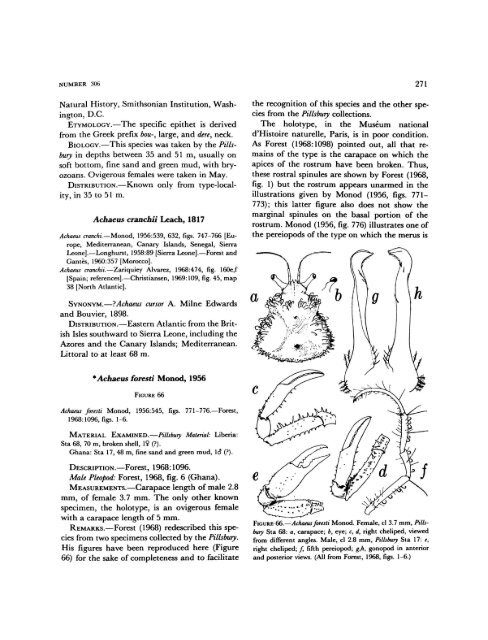West African Brachyuran Crabs - Smithsonian Institution Libraries
West African Brachyuran Crabs - Smithsonian Institution Libraries
West African Brachyuran Crabs - Smithsonian Institution Libraries
Create successful ePaper yourself
Turn your PDF publications into a flip-book with our unique Google optimized e-Paper software.
NUMBER 306 271<br />
Natural History, <strong>Smithsonian</strong> <strong>Institution</strong>, Washington,<br />
D.C.<br />
ETYMOLOGY.—The specific epithet is derived<br />
from the Greek prefix bou-, large, and dere, neck.<br />
BIOLOGY.—This species was taken by the Pillsbury<br />
in depths between 35 and 51m, usually on<br />
soft bottom, fine sand and green mud, with bryozoans.<br />
Ovigerous females were taken in May.<br />
DISTRIBUTION.—Known only from type-locality,<br />
in 35 to 51 m.<br />
Achaeus cranchii Leach, 1817<br />
Achaeus cranchi.—Monod, 1956:539, 632, figs. 747-766 [Europe,<br />
Mediterranean, Canary Islands, Senegal, Sierra<br />
Leone].—Longhurst, 1958:89 [Sierra Leone].—Forest and<br />
Games, 1960:357 [Morocco].<br />
Achaeus cranchii.—Zariquiey Alvarez, 1968:474, fig. 160e,f<br />
[Spain; references].—Christiansen, 1969:109, fig. 45, map<br />
38 [North Atlantic].<br />
SYNONYM.—?Achaeus cursor A. Milne Edwards<br />
and Bouvier, 1898.<br />
DISTRIBUTION.—Eastern Atlantic from the British<br />
Isles southward to Sierra Leone, including the<br />
Azores and the Canary Islands; Mediterranean.<br />
Littoral to at least 68 m.<br />
* Achaeus foresti Monod, 1956<br />
FIGURE 66<br />
Achaeus foresti Monod, 1956:545, figs. 771-776.—Forest,<br />
1968:10%, figs. 1-6.<br />
MATERIAL EXAMINED.—PUlsbury Material: Liberia:<br />
Sta 68, 70 m, broken shell, 1$ (?).<br />
Ghana: Sta 17, 48 m, fine sand and green mud, 16* (?).<br />
DESCRIPTION.—Forest, 1968:1096.<br />
Male Pleopod: Forest, 1968, fig. 6 (Ghana).<br />
MEASUREMENTS.—Carapace length of male 2.8<br />
mm, of female 3.7 mm. The only other known<br />
specimen, the holotype, is an ovigerous female<br />
with a carapace length of 5 mm.<br />
REMARKS.—Forest (1968) redescribed this species<br />
from two specimens collected by the PUlsbury.<br />
His figures have been reproduced here (Figure<br />
66) for the sake of completeness and to facilitate<br />
the recognition of this species and the other species<br />
from the PUlsbury collections.<br />
The holotype, in the Museum national<br />
d'Histoire naturelle, Paris, is in poor condition.<br />
As Forest (1968:1098) pointed out, all that remains<br />
of the type is the carapace on which the<br />
apices of the rostrum have been broken. Thus,<br />
these rostral spinules are shown by Forest (1968,<br />
fig. 1) but the rostrum appears unarmed in the<br />
illustrations given by Monod (1956, figs. 771—<br />
773); this latter figure also does not show the<br />
marginal spinules on the basal portion of the<br />
rostrum. Monod (1956, fig. 776) illustrates one of<br />
the pereiopods of the type on which the merus is<br />
h<br />
FIGURE-66.—Achaeus foresti Monod. Female, cl 3.7 mm, PUlsbury<br />
Sta 68: a, carapace; b, eye; c, d, right cheliped, viewed<br />
from different angles. Male, cl 2.8 mm, PUlsbury Sta 17: e,<br />
right cheliped; /, fifth pereiopod; g,h, gonopod in anterior<br />
and posterior views. (All from Forest, 1968, figs. 1-6.)

















